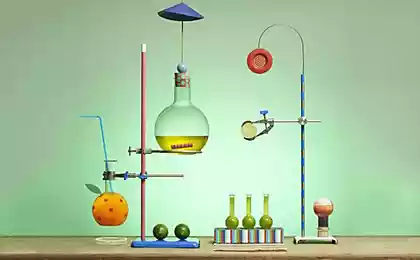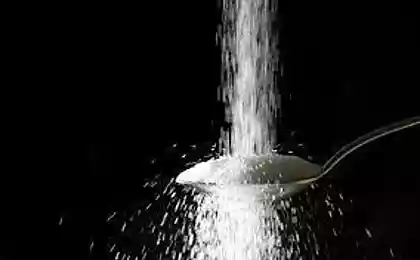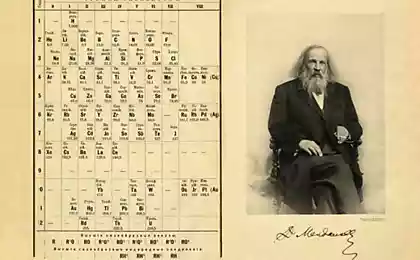832
10 mind-blowing scientific achievements
The future is nastupilo
Thanks to science there are always new ideas and things that make our lives better. Some of the scientific achievements of perfectly ordinary, while others are too crazy to believe in them. Before you - a list of the ten most crazy achievements that may come into our lives in the near future. Yes, it is a reality.
1. An electrically tsement
When it comes to good conductors of cement and not think. But recently, scientists from the University of Alicante created a cement that can effectively conduct heat and electricity, without losing the strength of ordinary cement.
At first glance, an electrically conductive cement does not seem stunning scientific achievement, but the possibilities for its use are very wide - it can be used on runways at airports and on the roads to prevent the accumulation of snow and glaciers.
An electrically conductive cement can be placed directly on a normal to give to thermal and electrical conductivity. The structure of the new cement include carbon nanotubes. The material has successfully passed several tests, and scientists are now working to improve it.
2. Bose-Eynshteyna
Satiendra Bose and Albert Einstein were the first in 1920 suggested the possible existence of Bose-Einstein condensates. Modern technology has allowed it to create an entirely new form of matter. Bose-Einstein condensates exist at extremely low temperatures - it's such a plasma, "on the contrary" (normal plasma exists only at extremely high temperatures).
Scientists have found that in such extreme conditions, the atoms start to behave very strangely. Although no one has not yet managed to slow the particle so as to stop any movement of molecules, the scientists turned to recreate the cold temperatures in the known universe right here on Earth. As a result, it managed to slow the particles at a temperature of only a billionth of a degree above absolute zero.
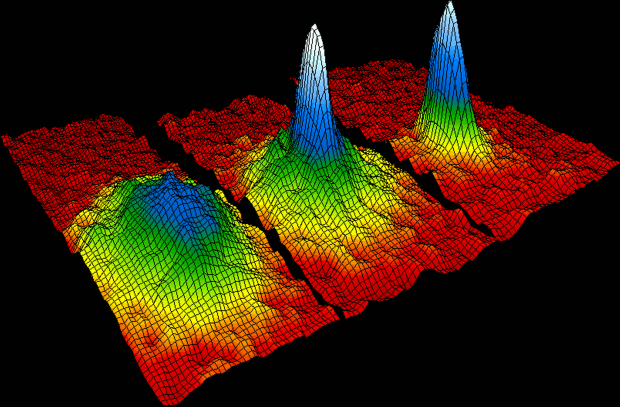
Researchers at Cornell and Weyman used rubidium atoms and found that the atoms are grouped together to form a "superatom." All their properties are preserved, but the transition to a new level, and thus behave very strangely.
3. superslippery cover «LiquiGlide»
Surely you were annoyed when the last drop of ketchup or shampoo could not shake the bottle. With the new material superslippery «LiquiGlide», developed by researchers at MIT, it will soon cease to be a problem.
«LiquiGlide» - non-toxic and incredibly slippery coating that can be applied in many areas. Although this is not the first "superhydrophobic" material, but that it was approved by the US supervision by the Food and Drug Administration.
«LiquiGlide» completely non-toxic, it can be used in food packaging. Just flip the bottle - and all the contents slip out of it without a trace. This not only helps companies to save money on building costly special caps and bottles, but also save you from anger - the last drop of ketchup guaranteed gets to the plate.
The coating can be applied to glass and plastic for a particular species. Companies already know about the new chudomateriale, so it should appear in our lives very, very soon.
4. Gas deep voice
We all know about the gas that makes the voice of the "cartoon", but to make our voice like Darth Vader, no gas is capable of. That has not been able to. Sulphur hexafluoride - an artificial connection to some pretty interesting and unique features. This is an incredibly dense and heavy particles: it can not only breathe and suddenly become a "supervillain," but to put things on it - it will be like levitation.
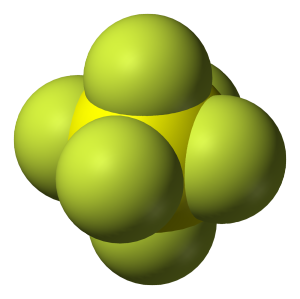
The speed of sound due to the weight of the gas slows down considerably when the sound is trying to pass through it, and as a result the voice becomes deeper. Furthermore, sulfur hexafluoride falls to the bottom of the container, since it is heavier than air, and then it is possible to put the foil pumps - will seem as if they are floating in the air.
Of course, playing with the gas pretty fun, but be careful, because if you breathe too deep gas settles in the lungs. It's not the air and exhale it will be extremely difficult.
5. Upsalit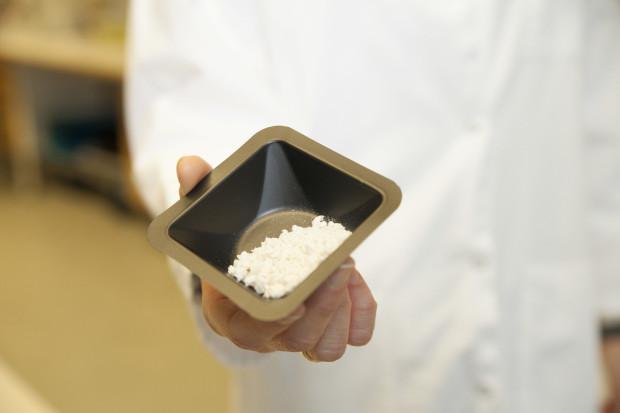
Researchers from the University of Uppsala in Sweden accidentally forgot to turn off the equipment at the weekend, so some days it worked unsupervised people. On Monday, they found powder per gram which can be distributed over the surface of 800 m².
This strange material - a perfect absorber. Zeolite, the most expensive absorbent material previously known, even hold a candle to him no good. Uppsala is very important - it can be used to control humidity, where it is really needed. And yet it is very easy and inexpensive to manufacture. The pores, which make up the surface upsalita less than 10 nm (a nanometer - is one billionth of a meter).
6. Nitinol
Nitinol - an alloy of nickel and titanium. The material was created in 1958 at the Laboratory of the US Navy, William and Frederick Van Buhler. It can be in two states - austenite and martensite - with completely different properties. At low temperatures (martensite) alloy can arbitrarily distort and manipulate them on your own, but at high temperatures (austenite), it regains its original shape.
The ability to miraculously take the initial form called memory thermal form. In addition, nitinol, due to its superelasticity may create superpruzhiny.
For medical purposes, nitinol is not very suitable due to the fact that it contains nickel, but it is useful where a lot of the details have to bend and move. As you know, after a while most of the metal in such conditions are broken, but the continuous bending the nitinol little harm. Now it is used in the industrial and technology sectors.
7. The liquid, which can breathe
While the idea may seem fantastic, people are still able to breathe with the help of liquid perfluorocarbons. These features make them perfluorocarbons capacitance - the ability to retain particles of oxygen.
Air capacitance 30 times greater than the water resistance and capacitance of perfluorocarbon is about 20 times greater than that of water. Imagine - you can fill in their pool and swim under water as you want. They may be included in suits to people swam like a fish, and for all forget about nitrogen narcosis. They can even save the lives of premature babies or people with respiratory problems.
8. The self-cleaning odezhda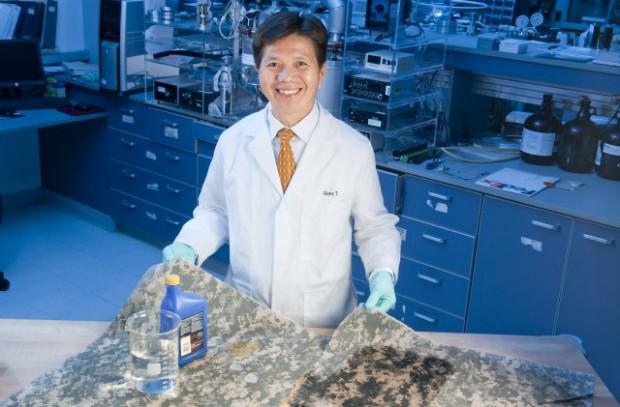
Say no washing! Scientists have finally created a material that solves the problem of dirty laundry. Special materials based on cotton only need sunlight. With a fall not only dirt and dust, and toxic chemicals.
He invented the material a student at UC Davis. He linked anthraquinone-2 carboxylic acid with cellulose and is embedded in this tissue. Gets on a tissue is destroyed mud-do the same peroxides with the bacteria into the wound.
Such clothing is quite expensive - What did you expect? However, according to the researchers, there are other chemicals that can give the same effect at the lowest cost.
But do not rush to sell the washing machine - self-cleaning clothes on the shelves will not appear for a long time. The first surprising fabric will be used in hospitals or military purposes, where it is obviously necessary.
9. Oxygen inektsii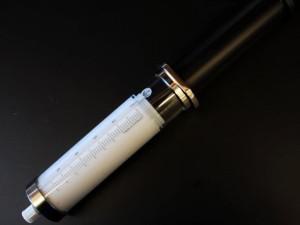
With new oxygen injection soon everyone will be able to hold their breath for 30 minutes, without experiencing any discomfort. The discovery was made at the Boston Children's Hospital. Each particle is surrounded by a fatty preparation material, so that it can easily enter the bloodstream. After injection, the oxygen level in the blood to normal within a few seconds.
Good particle that does not occur after injection embolism (bubbles) - particle specially deformed, entering the human body. The number of applications is infinite - chudochastitsy can save millions of people with respiratory insufficiency or those with respiratory problems.
10. Cloak nevidimka
Cloak of invisibility - it's flowers. Scientists have found a way to disguise the time. How? They understand how to manipulate the light velocity, accelerating a wave at the beginning and at the end of a delaying optical fiber. Thus, no one can even notice what you're doing.
In essence, the technology creates a "hole" in space and time in which you can do anything. The possibility of this has been mathematically proven back in 2010, the year (Harry Potter does not count), and since then, over her work successfully.
The researchers intend to make the invisibility cloak - woven optical fibers in a cloak as a material: everything is under his cloak, it will be impossible to see.
via factroom.ru

Thanks to science there are always new ideas and things that make our lives better. Some of the scientific achievements of perfectly ordinary, while others are too crazy to believe in them. Before you - a list of the ten most crazy achievements that may come into our lives in the near future. Yes, it is a reality.
1. An electrically tsement

When it comes to good conductors of cement and not think. But recently, scientists from the University of Alicante created a cement that can effectively conduct heat and electricity, without losing the strength of ordinary cement.
At first glance, an electrically conductive cement does not seem stunning scientific achievement, but the possibilities for its use are very wide - it can be used on runways at airports and on the roads to prevent the accumulation of snow and glaciers.
An electrically conductive cement can be placed directly on a normal to give to thermal and electrical conductivity. The structure of the new cement include carbon nanotubes. The material has successfully passed several tests, and scientists are now working to improve it.
2. Bose-Eynshteyna

Satiendra Bose and Albert Einstein were the first in 1920 suggested the possible existence of Bose-Einstein condensates. Modern technology has allowed it to create an entirely new form of matter. Bose-Einstein condensates exist at extremely low temperatures - it's such a plasma, "on the contrary" (normal plasma exists only at extremely high temperatures).
Scientists have found that in such extreme conditions, the atoms start to behave very strangely. Although no one has not yet managed to slow the particle so as to stop any movement of molecules, the scientists turned to recreate the cold temperatures in the known universe right here on Earth. As a result, it managed to slow the particles at a temperature of only a billionth of a degree above absolute zero.

Researchers at Cornell and Weyman used rubidium atoms and found that the atoms are grouped together to form a "superatom." All their properties are preserved, but the transition to a new level, and thus behave very strangely.
3. superslippery cover «LiquiGlide»

Surely you were annoyed when the last drop of ketchup or shampoo could not shake the bottle. With the new material superslippery «LiquiGlide», developed by researchers at MIT, it will soon cease to be a problem.
«LiquiGlide» - non-toxic and incredibly slippery coating that can be applied in many areas. Although this is not the first "superhydrophobic" material, but that it was approved by the US supervision by the Food and Drug Administration.
«LiquiGlide» completely non-toxic, it can be used in food packaging. Just flip the bottle - and all the contents slip out of it without a trace. This not only helps companies to save money on building costly special caps and bottles, but also save you from anger - the last drop of ketchup guaranteed gets to the plate.
The coating can be applied to glass and plastic for a particular species. Companies already know about the new chudomateriale, so it should appear in our lives very, very soon.
4. Gas deep voice
We all know about the gas that makes the voice of the "cartoon", but to make our voice like Darth Vader, no gas is capable of. That has not been able to. Sulphur hexafluoride - an artificial connection to some pretty interesting and unique features. This is an incredibly dense and heavy particles: it can not only breathe and suddenly become a "supervillain," but to put things on it - it will be like levitation.

The speed of sound due to the weight of the gas slows down considerably when the sound is trying to pass through it, and as a result the voice becomes deeper. Furthermore, sulfur hexafluoride falls to the bottom of the container, since it is heavier than air, and then it is possible to put the foil pumps - will seem as if they are floating in the air.
Of course, playing with the gas pretty fun, but be careful, because if you breathe too deep gas settles in the lungs. It's not the air and exhale it will be extremely difficult.
5. Upsalit

Researchers from the University of Uppsala in Sweden accidentally forgot to turn off the equipment at the weekend, so some days it worked unsupervised people. On Monday, they found powder per gram which can be distributed over the surface of 800 m².
This strange material - a perfect absorber. Zeolite, the most expensive absorbent material previously known, even hold a candle to him no good. Uppsala is very important - it can be used to control humidity, where it is really needed. And yet it is very easy and inexpensive to manufacture. The pores, which make up the surface upsalita less than 10 nm (a nanometer - is one billionth of a meter).
6. Nitinol
Nitinol - an alloy of nickel and titanium. The material was created in 1958 at the Laboratory of the US Navy, William and Frederick Van Buhler. It can be in two states - austenite and martensite - with completely different properties. At low temperatures (martensite) alloy can arbitrarily distort and manipulate them on your own, but at high temperatures (austenite), it regains its original shape.
The ability to miraculously take the initial form called memory thermal form. In addition, nitinol, due to its superelasticity may create superpruzhiny.
For medical purposes, nitinol is not very suitable due to the fact that it contains nickel, but it is useful where a lot of the details have to bend and move. As you know, after a while most of the metal in such conditions are broken, but the continuous bending the nitinol little harm. Now it is used in the industrial and technology sectors.
7. The liquid, which can breathe
While the idea may seem fantastic, people are still able to breathe with the help of liquid perfluorocarbons. These features make them perfluorocarbons capacitance - the ability to retain particles of oxygen.
Air capacitance 30 times greater than the water resistance and capacitance of perfluorocarbon is about 20 times greater than that of water. Imagine - you can fill in their pool and swim under water as you want. They may be included in suits to people swam like a fish, and for all forget about nitrogen narcosis. They can even save the lives of premature babies or people with respiratory problems.
8. The self-cleaning odezhda

Say no washing! Scientists have finally created a material that solves the problem of dirty laundry. Special materials based on cotton only need sunlight. With a fall not only dirt and dust, and toxic chemicals.
He invented the material a student at UC Davis. He linked anthraquinone-2 carboxylic acid with cellulose and is embedded in this tissue. Gets on a tissue is destroyed mud-do the same peroxides with the bacteria into the wound.
Such clothing is quite expensive - What did you expect? However, according to the researchers, there are other chemicals that can give the same effect at the lowest cost.
But do not rush to sell the washing machine - self-cleaning clothes on the shelves will not appear for a long time. The first surprising fabric will be used in hospitals or military purposes, where it is obviously necessary.
9. Oxygen inektsii

With new oxygen injection soon everyone will be able to hold their breath for 30 minutes, without experiencing any discomfort. The discovery was made at the Boston Children's Hospital. Each particle is surrounded by a fatty preparation material, so that it can easily enter the bloodstream. After injection, the oxygen level in the blood to normal within a few seconds.
Good particle that does not occur after injection embolism (bubbles) - particle specially deformed, entering the human body. The number of applications is infinite - chudochastitsy can save millions of people with respiratory insufficiency or those with respiratory problems.
10. Cloak nevidimka

Cloak of invisibility - it's flowers. Scientists have found a way to disguise the time. How? They understand how to manipulate the light velocity, accelerating a wave at the beginning and at the end of a delaying optical fiber. Thus, no one can even notice what you're doing.
In essence, the technology creates a "hole" in space and time in which you can do anything. The possibility of this has been mathematically proven back in 2010, the year (Harry Potter does not count), and since then, over her work successfully.
The researchers intend to make the invisibility cloak - woven optical fibers in a cloak as a material: everything is under his cloak, it will be impossible to see.
via factroom.ru
The best job in the world - Head of entertainment
Skyscraper "Tower of David" in Venezuela - an amazing vertical slum



